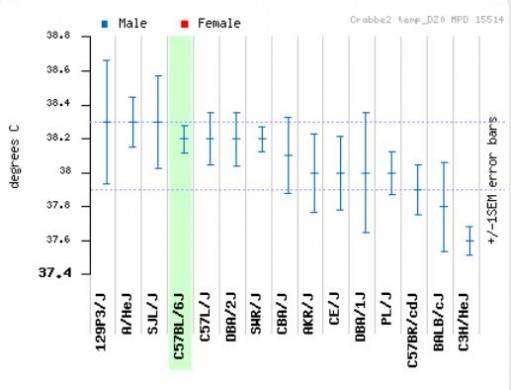C57BL/6 mice (endearingly known as B6) are the most commonly used inbred strain in laboratories worldwide. You probably already knew that. But did you know that males can swim for an average of 591 minutes after receiving swimming lessons for 5 weeks? Or that both males and females voluntarily consume more ethanol (i.e. alcohol) than other strains? If not, you should check out the Mouse Phenome Database (MPD), where you can find these types of data and much more.
‘What is MPD, and where has it been all my life?’
If you find yourself asking this question, you’re not alone. MPD is a free bioinformatics resource of collaborative standardized experimental data using laboratory mouse strains. It includes baseline phenotype data sets as well as studies on the effects of different drugs, diet, disease and aging on mice.
In MPD you’ll find protocols, projects and publications, as well as SNP variation and gene-expression studies for more than 40 of the most popular inbred strains and for a few mutant strains, too. You can then use these data to spend less time conducting control experiments or taking control measurements on wild-type, inbred mice and instead focus on making that new discovery.
For example, using the well-documented protocols provided for each data set, you can validate an assay in your own facility using your inbred control mice. Once validated, you can utilize fewer control mice in your targeted experiment – perhaps with a new knockout mouse – and achieve the same confidence in your data, saving you time and resources.
With thousands of data points for measurements like body weight, total white blood cell counts, or baseline hormone levels (the list goes on!), you can take advantage of the work that other scientists have already done and use it to design new experiments or validate data that you’ve already gathered.
Beyond just finding baseline data for a particular strain, tools also are available to compare data for different strains to help choose the best one for your studies; for example, if you are measuring fever induction after a challenge, you may want to use a strain with a lower baseline body temperature, such as C3H/HeJ or BALB/cJ.

You also can use baseline information to make more informed strain choices for gene-discovery applications. Suppose, for example, that you want to understand the genes involved in regulating blood pressure. One approach is to breed two strains with very different baseline blood pressure levels together to produce animals with segregating blood pressure phenotypes. QTL mapping in the F2 progeny of such a cross may help to identify candidate genes that underlie that phenotype. Using the data available in MPD to choose your strains will save you both the time that you otherwise might have spent searching the literature for the relevant information and the effort that you might have invested conducting your own strain survey experiments.
An additional feature of MPD is the capability to input your own data and compare it side-by-side with published data. You can even export the result into a worksheet. So if you are measuring a particular strain’s response to a high-fat diet or a specific infection (yes, even intervention studies are available too), you can download individual values and directly compare it with your data.
Whether you’re interested in knowing if your mice have a sweet tooth or if they’re heavy drinkers, MPD is the place to find baseline data to help streamline your experiments and budget. So stop wasting your hard-earned grant money on breeding control mice and start validating your data with MPD!